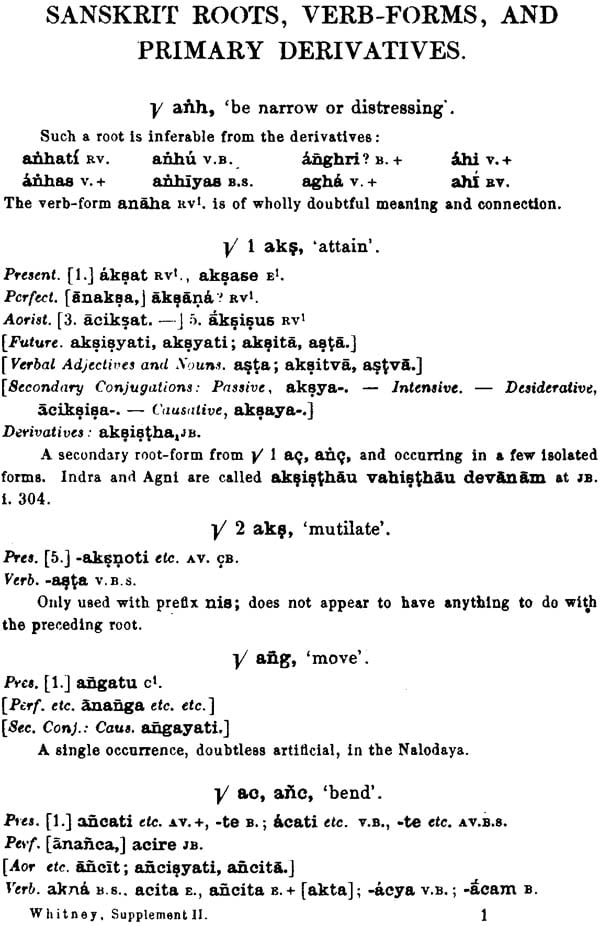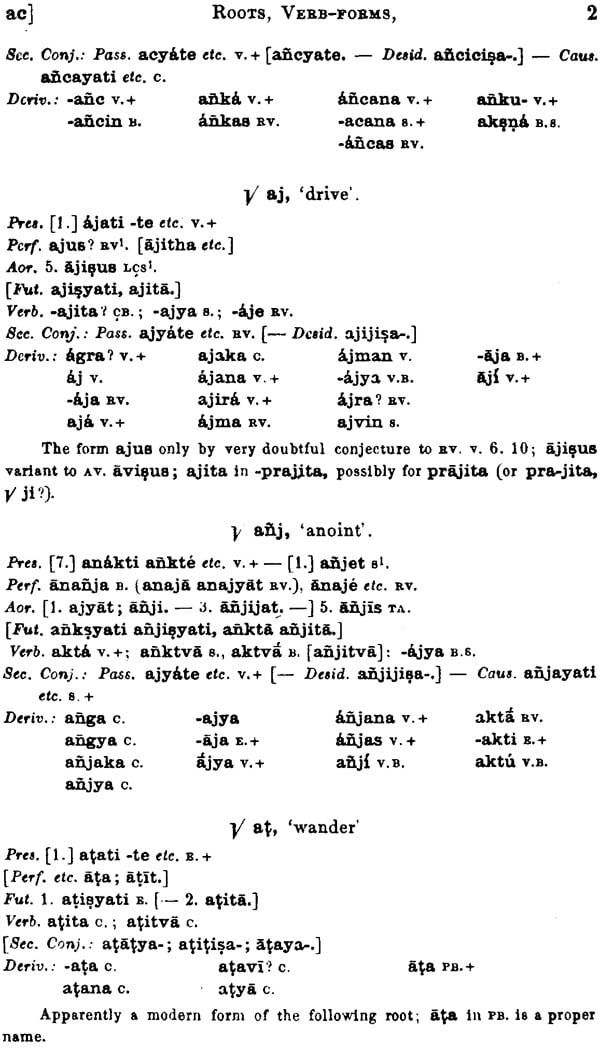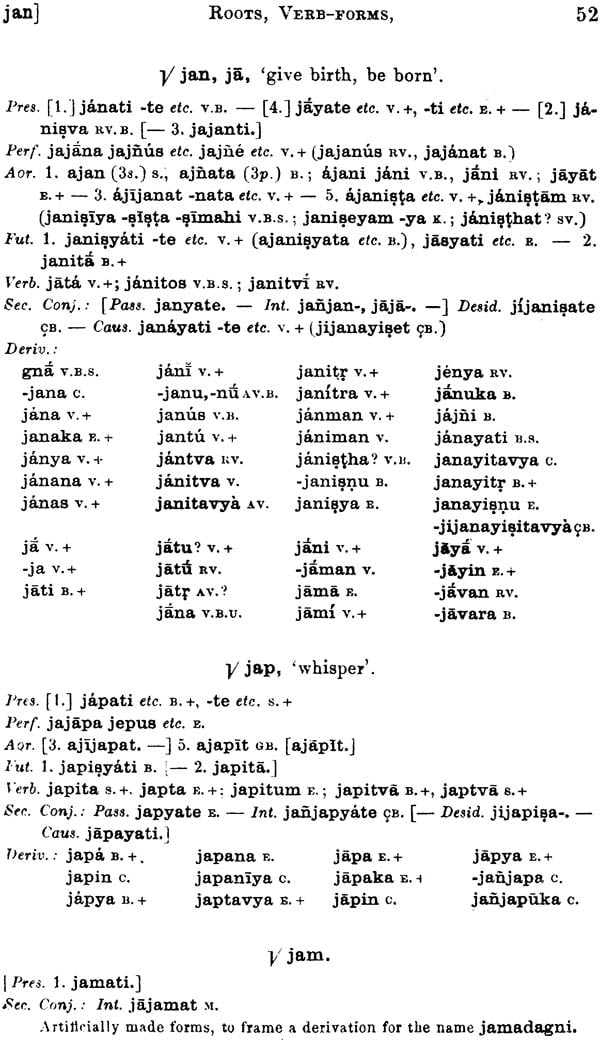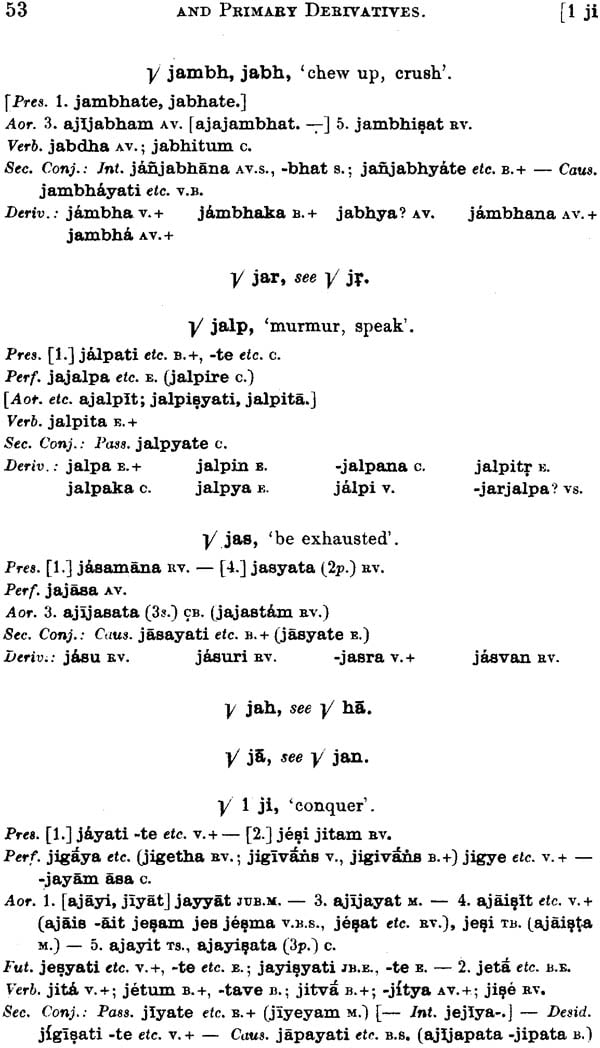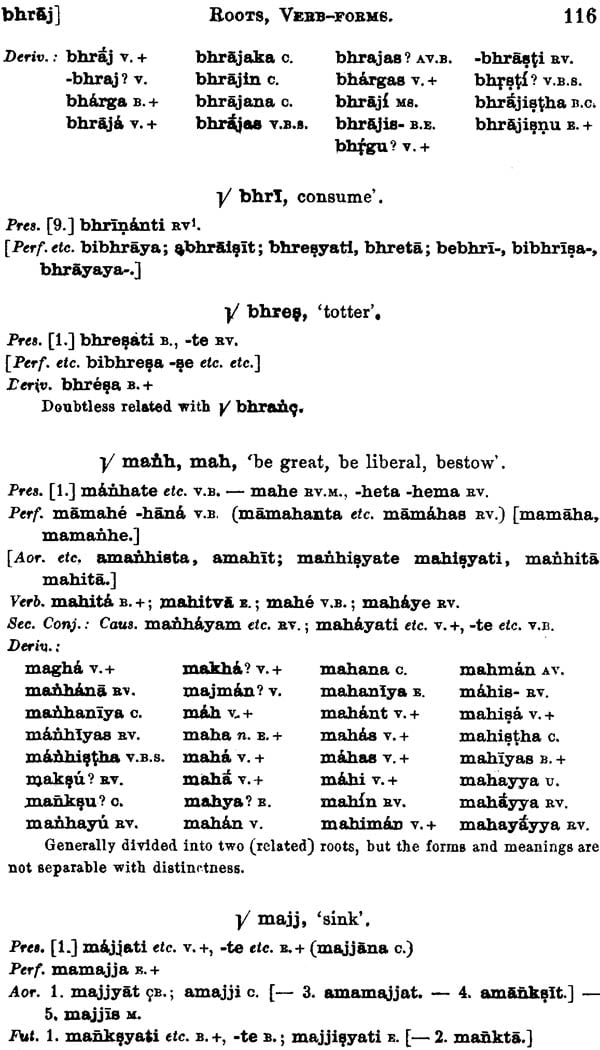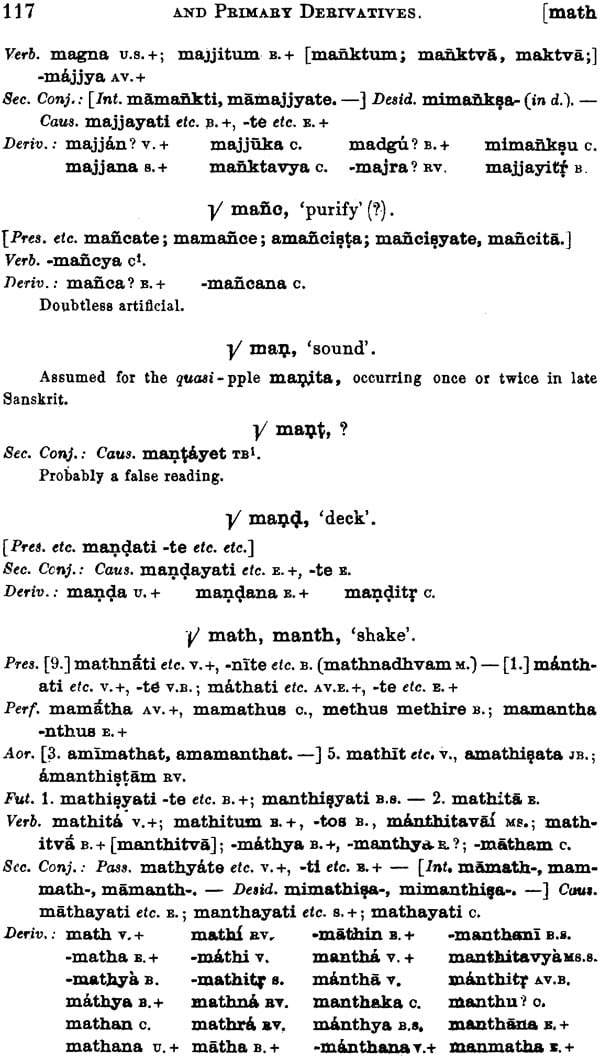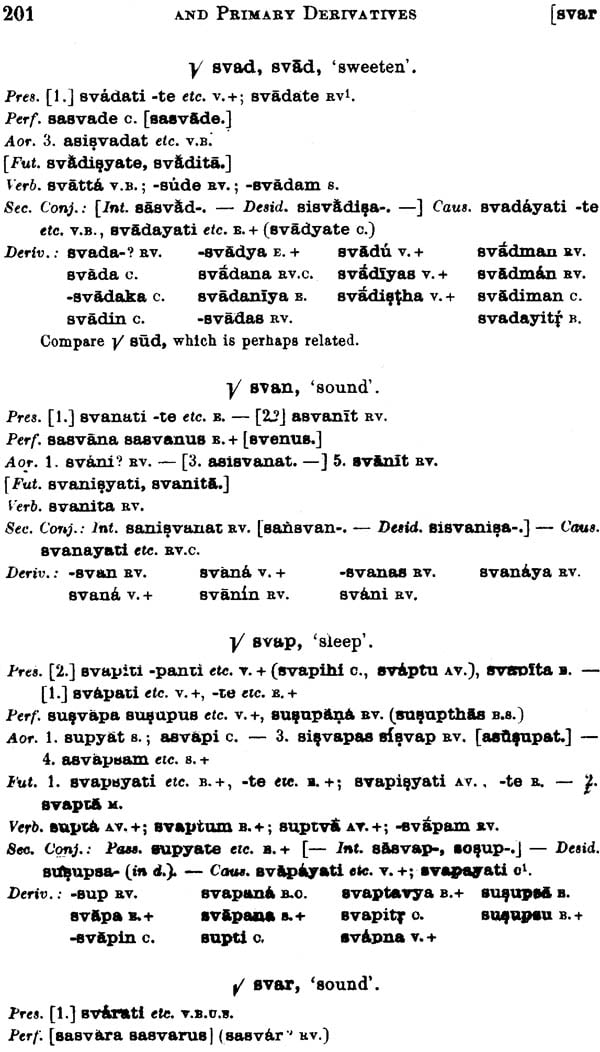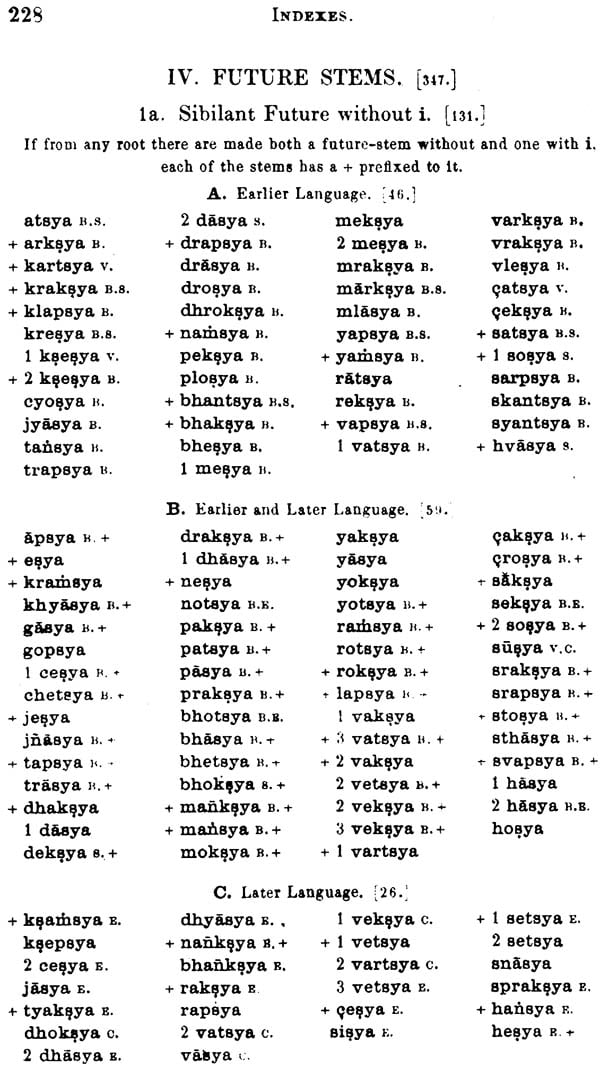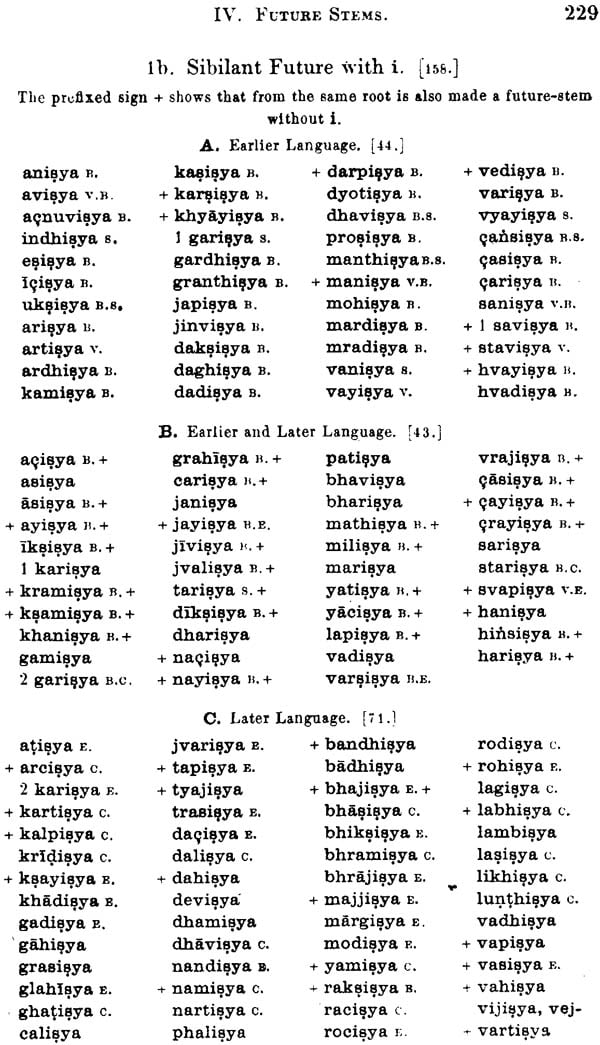
THE ROOTS, VERB-FORMS AND PRIMARY DERIVATIVES OF THE SANSKRIT LANGUAGE
Book Specification
| Item Code: | IDD547 |
| Author: | WILLIAM DWIGHT WHITNEY |
| Publisher: | MOTILAL BANARSIDASS DELHI |
| Language: | English |
| Edition: | 2016 |
| ISBN: | 9788120804852 |
| Pages: | 264 |
| Cover: | Paperback |
| Other Details | 8.5" X 5.5" |
| Weight | 370 gm |
Book Description
About the Book:
This work is a intended especially as a Supplement to the author's Sanskrit Grammar giving a fulness of detail that was not there practicable, nor admissible as part of the grammar itself, all the quotable roots of the language, with the tense and conjugation-systems made from them, and with the noun and adjective (infinitival and participal) formation that attach themselves most closely to the verb; and further with the other derivative noun and adjective-stems usually classed as primary. Everything given is dated with such accuracy as the information thus far in hand allows.
In the indexes of stem given at the end of the volume, a classification is adopted which is intended to facilitate the historical comprehension of the language, by distinguishing what belongs respectively to its older and to its later periods from that which forms a part of it through the whole history.
This work is intended especially as a Supplement to my Sanskrit Grammar (Leipzig, 1879), giving, with a fullness of detail that was not then practicable, nor admissible as part, of the grammar itself, all the quotable roots of the language with the tense and conjugafition systems made from them, and with the noun and adjective (infinitival and participial) formations that attach themselves most closely to the verb;. and further, with the other derivative noun and adjective stems usually classed as primary: since these also are needed, if one would have a comprehensive view of the value of a given root in the language. And everything given is dated, with such accuracy as the information thus far in hand allows- whether found in I the language I throughout its whole history, or limited to a certain period.
My leading authority has necessarily been that magnificent thesaurus of authentic, information respecting the Sanskrit language of every period, the great St. Peters burg Lexicon of Bohtlingk and Roth. This I have gone I carefully over, excerpting all the material needed for my, purpose. Sol far, indeed, as concerns the epic and classical literature, the Lexicon has been almost my sole source, since my own collections, for verification or of additional material, though not wholly wanting, have yet been al-I together insignificant as compared with it. But in the older o language, of Veda and Brahmana and Upanishad and Sutra, I have done much more independent work. I have, namely, gone over all the texts of the earlier period accessible to me, including (by the kindness of Professor Weber) the as yet unpublished Kausitaki—Brahmana and Kathaka, and (by the kindness of the late Dr. Burnell) the immense Jaiminiya or Talavakar-Bi•ahmana, which has as yet hardly been accessible to any one else; and from them I have excerpted all the noteworthy verbal forms and (less completely) the primary derivatives; thus verifying and occasionally correcting the material of the Lexicon, supplying chance omissions, and especially filling in not a few details which it had not lain in the design of that work to present in their entirety.
As a matter of course, no such work as the present can pretend to completeness, especially at its first appearance. The only important texts of which we have exhaustive verbal indexes are the Rig-Veda and the Atharva-Veda, nor is it known that any other is in preparation; and only where such indexes exist can the inclusion of all that a text contains be assured. But I trust it will be found that the measure of completeness here attained is in general proportioned to the importance of the material: that it is the more indifferent forms and derivatives which, having been passed over by the Lexicon, have escaped my gleaning also. I expect to continue the work of verification and addition, and to make an eventual future edition perceptibly nearer to perfection in its details, and possessing such improvements in plan as my own experience and the criticisms of others may suggest? It is unnecessary to add that corrections and additions of any kind will be welcomed by me, and duly acknowledged
Of the verb-form which, though. Not yet found and, for the most part, destined never to be found — in recorded. Use, are prescribed or authorized by the Hindu grammarians, a liberal presentation is made under the different roots: such material being always distinguished from the other by being put in the square brackets. It is in no part given at first hand, but only as reported by Western authorities: the Lexicon, Westergaard’s Radices, and the various European grammars; all of these supplement rather than contradict one another; and any occasional disagreement among them is passed over, as relating to a matter of too little consequence to be worth reporting.
The periods in the life of the language which are acknowledged and distinguished by appropriate notation are six: the Veda (Marked with v.), the Brahmana (with B.), the earlier or more genuine Upanishads (with U.), the Sutras (with s.), the epics, Mahabharata and Ramayana (with E), and the classical or common Sanskrit (with C.), This classification, however, is by no means an absolute one, and calls for certain explanations and limitations, as follows.
Under ‘Veda’ (v.) are included only the indexed texts of the Rig-Veda, Sama-Veda, and Atharva-Veda. In strictness, certain passages of the Atharva-Veda should have been excluded, as being in prose and Brahmana-like; and, what is of much more importance, the older and better part of the mantra-material in the various samhita’s of the Yajur-Veda, in the Brahmanas, and even in the Sutras, is quite as good Veda as most of the Atharvan, some of it even as parts of the Rik. In the present condition of things, however, it did not seem to me practicably to draw the division-line otherwise than in the partly arbitrary way in which I have drawn it. When the mantra-material is collected from all places and compared (as it by all means ought soon to be), it will be possible to use the term ‘Veda’ in a more exact sense, both inclusively and exclusively – though between what is genuinely old and what is in an artificially antique style a definite separation will probably never admit of being made.
lt is further to be stated that in the following lists r nothing is intended to be marked with simple v., as ‘Vedic`, that does not occur the Rig.-Vedas; what is not Rig- Vedic though it may be found in both the other collections, is marked av., or sv., or both, as the case may be. On the other hand, if anything occurring only in the Rik among r the three Vedas is found also in later periods, the fact that it does not chance to he met with in the Atharvan or Sal- man is too unimportant to notice, and (save perhaps in exceptional cases) it is marked v.b. or the like.
Between Brahmana, Aranyaka and Upanishad, again, y the line of division is an evanescent one, and perhaps hardly worth the attempt at drawing. But I have followed the method of distinguishing by a U. the small number r of these treatises that have an existence separate from Brahmana or Aranyaka, while not distinguishing the two • latter- from one another. The sign U. is the one of least importance and least frequency in the system adopted
The division of Sutras is.) is a plainer one except so, far as these treatises contain mantra—material in their quoted verses (as. already intimated) — and brahmana-material also in their quoted formulas. The proper language of the Sutras themselves is a true continuator of that of the Brahrnanas.
As epic (e:.} are reckoned only the two great poems, the Mahabharata and Ramayana. And in these it has, of course, l been impossible to distinguish between the older and the more recent parts: although, beyond a question, a considerable part of both is in no manner distinguishable from the general later literature, except by a degree archaizing neglect of the strict requirements of the native grammar.
Everything else that is Sanskrit falls under the head of classical (c.), or, of the language as written under the domination of the native system of grammar. Here the only subdivision which one is tempted to make is to mark separately those forms and words which are found used only in the commentaries, and which are therefore open to a heightened suspicion of artificiality; but this I have not tried to do.
A plus-sign (+) indicates that the given formation is found to occur from the specified period onward, even to the latest or classical period.
Instead of a period, an individual text is sometimes referred to yet not upon any very definite and consistent plan (except in the case of the Vedas, as explained above). A ‘superior’ figure (e. g. RV.) indicates the number of times a word or form has been met with— yet this, again, only in exceptional instances, and not in the case of every unique or very rare occurrence.
So far as the present—system is concerned, only so many specimen-forms are given as suffice to illustrate the mode of formation. lt world have been space and time thrown away to instance in each case the various sub—for motions — modes, participles, imperfect that occur, since one form implies clearly, enough the possible existence of the rest. , The form taken as representative specimen is ordinarily the 3d singular, as being often more character- is to than the is and that person is even occasionally given when, in verbs of infrequent use, it is not itself, actually quotable. Irregular or exceptional forms, whether of the earlier or of the later language, are then added in parenthesis. Everywhere, an appended ‘etc.’ means that other forms of the same make occur: yet I find on review that- I have not used this sign consistently, and its absence must not be taken always as indicating more than that the variety of forms quotable is comparatively small., The various modes of present formation are intended to be given in the order of their relative regularity or frequency; to each is prefixed in brackets the number belonging to it in the order of the conjugation-classes as given by the Hindu grammarians —since. however meaningless and unworthy of retention this may be, it is still widely used, not only in the grammars, but even by general writers on language.
ln the other tense•—systems, while in the main the same method is followed, the intention nevertheless is to give, on account of their greater infrequency and irregularity. a conspectus of the various tenses and mode-—formations from the same stem (not, of course, the participles. except for aorist)r Thus, for example, no quotable precative, either active or middle, is designedly omitted under the aorist to which it belongs: nor any quotable conditional (under the first future; nor any pluperfect under the perfect. Moreover, in view of the rarity of the 2d sing perfect active and the useless prolixity of the native rules as to its formation, every example of it is given that has been found to occur. The order in which the aorists are presented is the systematic one, without reference to their frequency of use.
